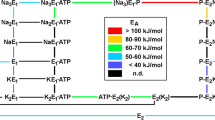Abstract
The proton dependence of the transport of three labelled, hydrolysis-resistant synthetic dipeptides carrying a net charge of −1, 0 or +1 has been investigated in a brush border membrane vesicle preparation obtained from rat renal cortex. Cross-inhibition studies are consistent with the transport of all peptides studied being through a single system. The extent and time course of uptake in response to an inwardly directed electrochemical gradient of protons differed for each peptide. For the cationic peptide D-Phe-L-Lys this gradient did not stimulate the initial rate of uptake, while for the neutral dipeptide D-Phe-L-Ala and the anionic peptide D-Phe-L-Glu stimulation was observed. However, the effect on D-Phe-L-Glu was more marked than that on D-Phe-L-Ala and the proton activation differed for these two peptides. The calculated Hill coefficients for the two proton-dependent peptides were 1.14±0.16 and 2.15±0.10 for D-Phe-L-Ala and D-Phe-L-Glu, respectively, providing evidence that the stoichiometry of proton: peptide cotransport is different for each peptide (0∶1, 1∶1 and 2∶1 for D-Phe-L-Lys, D-Phe-L-Ala and D-Phe-L-Glu respectively); studies on energetics are compatible with this conclusion. The physiological and molecular implications of this model are discussed, as are the applicability of the conclusions to secondary active transport systems more generally.
Similar content being viewed by others
References
Attwell D, Mobbs P (1994) Neurotransmitter transporters. Curr Opin Neurobiol 4:353
Bailey PD (1990) An introduction to peptide chemistry. Wiley, Chichester
Biber J, Steiger B, Haase W, Murer H (1981) A high yield preparation for rat kidney brush border membranes: different behaviour of lysosomal markers. Biochim Biophys Acta 647:169–176
Boll M, Markovich D, Weber WM, Korte H, Daniel H, Murer H (1994) Expression cloning of a cDNA from rabbit small intestine related to proton-coupled transport of peptides, B-lactam antibiotics and ACE-inhibitors. Pflügers Arch 429:146–149
Daniel H, Morse EL, Adibi SA (1991) The high and low affinity transport systems for dipeptides in kidney brush border membrane respond differently to alterations in pH gradient and membrane potential. J Biol Chem 266:19917–19924
Daniel H, Morse EL, Adibi SA (1992) Determinants of substrate affinity for the oligopeptide/H+ symporter in the renal brush border membrane. J Biol Chem 267:9565–9573
Eleno N, Devés R, Boyd CAR (1994) Membrane potential dependence of the kinetics of cationic amino acid transport systems in human placenta. J Physiol (Lond) 479:291–300
Fei YJ, Kanai Y, Nussgerger S, Ganapathy V, Leibach FH, Romero MF, Singh SK, Boron WF, Hediger MA (1994) Expression cloning of a mammalian proton-coupled oligopeptide transporter. Nature 368:563–566
Hediger MA, Kanai Y, You G, Nussberger S (1995) Mammalian ion-coupled solute transporters. J Physiol (Lond) 482:P 7S-17S
Hill AV (1910) The possible effects of the aggregation of the molecules of haemoglobin on its dissociation curves. J Physiol (Lond) 40:4–7
Lister N, Sykes AP, Bailey PD, Boyd CAR, Bronk JR (1995) Dipeptide transport and hydrolysis in isolated loops of rat small intestine: effects of stereo-specificity. J Physiol (Lond) 484:173–182
Matthews DM (1991) Protein absorption. Wiley New York
Paulson IT, Skurray RA (1994) The POT family of transport proteins. Trends Biochem sci 19:404
Temple CS, Bailey PD, Boyd CAR, Bronk JR, Collier ID, Lister N (1994) Voltage dependence of the kinetics of neutral dipeptide proton co-transport in rat renal brush border membrane vesicles. J Physiol (Lond) 481:34P
Author information
Authors and Affiliations
Rights and permissions
About this article
Cite this article
Temple, C.S., Bronk, J.R., Bailey, P.D. et al. Substrate-charge dependence of stoichiometry shows membrane potential is the driving force for proton-peptide cotransport in rat renal cortex. Pflugers Arch. 430, 825–829 (1995). https://doi.org/10.1007/BF00386182
Received:
Revised:
Accepted:
Issue Date:
DOI: https://doi.org/10.1007/BF00386182




